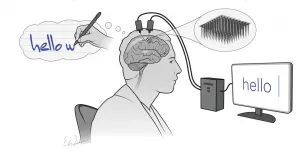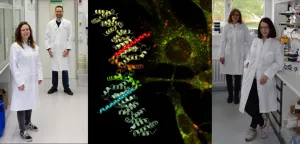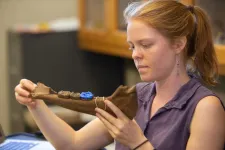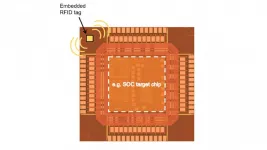A long-lasting, stable solid-state lithium battery
Researchers demonstrate a solution to a 40-year problem
2021-05-12
(Press-News.org) Long-lasting, quick-charging batteries are essential to the expansion of the electric vehicle market, but today's lithium-ion batteries fall short of what's needed -- they're too heavy, too expensive and take too long to charge.
For decades, researchers have tried to harness the potential of solid-state, lithium-metal batteries, which hold substantially more energy in the same volume and charge in a fraction of the time compared to traditional lithium-ion batteries.
"A lithium-metal battery is considered the holy grail for battery chemistry because of its high capacity and energy density," said Xin Li, Associate Professor of Materials Science at the Harvard John A. Paulson School of Engineering and Applied Science (SEAS). "But the stability of these batteries has always been poor."
Now, Li and his team have designed a stable, lithium-metal solid state battery that can be charged and discharged at least 10,000 times -- far more cycles than have been previously demonstrated --- at a high current density. The researchers paired the new design with a commercial high energy density cathode material.
This battery technology could increase the lifetime of electric vehicles to that of the gasoline cars -- 10 to 15 years -- without the need to replace the battery. With its high current density, the battery could pave the way for electric vehicles that can fully charge within 10 to 20 minutes.
The research is published in Nature.
"Our research shows that the solid-state battery could be fundamentally different from the commercial liquid electrolyte lithium-ion battery," said Li. "By studying their fundamental thermodynamics, we can unlock superior performance and harness their abundant opportunities."
The big challenge with lithium-metal batteries has always been chemistry. Lithium batteries move lithium ions from the cathode to the anode during charging. When the anode is made of lithium metal, needle-like structures called dendrites form on the surface. These structures grow like roots into the electrolyte and pierce the barrier separating the anode and cathode, causing the battery to short or even catch fire.
To overcome this challenge, Li and his team designed a multilayer battery that sandwiches different materials of varying stabilities between the anode and cathode. This multilayer, multimaterial battery prevents the penetration of lithium dendrites not by stopping them altogether but rather by controlling and containing them.
Think of the battery like a BLT sandwich. First comes the bread -- the lithium metal anode -- followed by lettuce -- a coating of graphite. Next, a layer of tomatoes -- the first electrolyte -- and a layer of bacon -- the second electrolyte. Finish it off with another layer of tomatoes and the last piece of bread -- the cathode.
The first electrolyte (chemical name Li5.5PS4.5Cl1.5 or LPSCI) is more stable with lithium but prone to dendrite penetration. The second electrolyte, (Li10Ge1P2S12 or LGPS) is less stable with lithium but appears immune to dendrites. In this design, dendrites are allowed to grow through the graphite and first electrolyte but are stopped when they reach the second. In other words, the dendrites grow through the lettuce and tomato but stop at the bacon. The bacon barrier stops the dendrites from pushing through and shorting the battery.
"Our strategy of incorporating instability in order to stabilize the battery feels counterintuitive but just like an anchor can guide and control a screw going into a wall, so too can our multilayer design guide and control the growth of dendrites," said Luhan Ye, co-author of the paper and graduate student at SEAS. "The difference is that our anchor quickly becomes too tight for the dendrite to drill through, so the dendrite growth is stopped," Li added.
The battery is also self-healing; its chemistry allows it to backfill holes created by the dendrites.
"This proof-of-concept design shows that lithium-metal solid-state batteries could be competitive with commercial lithium-ion batteries," said Li. "And the flexibility and versatility of our multilayer design makes it potentially compatible with mass production procedures in the battery industry. Scaling it up to the commercial battery wont' be easy and there are still some practical challenges, but we believe they will be overcome."
INFORMATION:
The research was supported by Dean's Competitive Fund for Promising Scholarship at Harvard University and Harvard Data Science Initiative Competitive Research Fund. Further developments of this project will be supported by Harvard Physical Sciences and Engineering Accelerator Award and Harvard Climate Change Solutions Fund.
ELSE PRESS RELEASES FROM THIS DATE:
2021-05-12
Scientists have developed a brain-computer interface (BCI) designed to restore the ability to communicate in people with spinal cord injuries and neurological disorders such as amyotrophic lateral sclerosis (ALS). This system has the potential to work more quickly than previous BCIs, and it does so by tapping into one of the oldest means of communications we have--handwriting.
The study, published in Nature, was funded by the National Institutes of Health's Brain Research Through Advancing Innovative Neurotechnologies® (BRAIN) Initiative as well as the National Institute of Neurological Disorders and Stroke (NINDS) and the National Institute on Deafness and Other Communication Disorders (NIDCD), both part of the NIH.
Researchers focused on the part of the brain ...
2021-05-12
Woods Hole, Mass. (May 12, 2021) -- Low-to-mid latitude land surfaces at low elevation cooled on average by 5.8 ± 0.6 degrees C during the Last Glacial Maximum (LGM), based on an analysis of noble gases dissolved in groundwater, according to a new study published in Nature.
Temperature estimates in the study are substantially lower than indicated by some notable marine and low-elevation terrestrial studies that have relied on various proxies to reconstruct past temperatures during the LGM, a period about 20,000 years ago that represents the most recent extended period ...
2021-05-12
Tuberous Sclerosis Complex (TSC) affects between one and two of every 10,000 new-born babies. This genetic disease leads to the formation of benign tumours which can massively impair the proper functioning of vital organs such as the kidneys, the liver and the brain. The disease affects different patients to varying degrees and is triggered by mutations in one of two genes, the TSC1 or TSC2 gene. An interdisciplinary team of researchers led by biochemists Prof. Daniel Kümmel and Dr. Andrea Oeckinghaus from the University of Münster (Germany) examined the "tumour suppressor protein TSC1" and, for the first time, gained insights into its hitherto unclear functions. The team identified a new mechanism, in a central cellular process, which regulates ...
2021-05-12
University of Cincinnati researchers studied the teeth of prehistoric horses and bison in the Arctic to learn more about their diets compared to modern species.
What they found suggests the Arctic 40,000 years ago maintained a broader diversity of plants that, in turn, supported both more -- and more diverse -- big animals.
The Arctic today is spartan compared to the wildlife-rich landscape during the ice ages of the Pleistocene epoch between 12,000 and 2.6 million years ago when wild horses, mammoths, bison and other big animals roamed the steppes and grasslands of what is now northern Canada, northern Europe, Alaska and Siberia. Short-faced bears, ground sloths and even cave lions called the 49th State home.
The Arctic supported greater populations ...
2021-05-12
Researchers at North Carolina State University have made what is believed to be the smallest state-of-the-art RFID chip, which should drive down the cost of RFID tags. In addition, the chip's design makes it possible to embed RFID tags into high value chips, such as computer chips, boosting supply chain security for high-end technologies.
"As far as we can tell, it's the world's smallest Gen2-compatible RFID chip," says Paul Franzon, corresponding author of a paper on the work and Cirrus Logic Distinguished Professor of Electrical and Computer Engineering at NC State.
Gen2 RFID chips are state of the art and are already in widespread use. One of the things that sets ...
2021-05-12
Meat that is certified organic by the U.S. Department of Agriculture is less likely to be contaminated with bacteria that can sicken people, including dangerous, multidrug-resistant organisms, compared to conventionally produced meat, according to a study from researchers at the Johns Hopkins Bloomberg School of Public Health.
The findings highlight the risk for consumers to contract foodborne illness--contaminated animal products and produce sicken tens of millions of people in the U.S. each year--and the prevalence of multidrug-resistant organisms that, when they lead to illness, can complicate treatment.
The researchers found that, compared to conventionally processed meats, organic-certified meats were 56 percent less likely to be contaminated with ...
2021-05-12
Loss of smell, or anosmia, is one of the earliest and most commonly reported symptoms of COVID-19. But the mechanisms involved had yet to be clarified. Scientists from the Institut Pasteur, the CNRS, Inserm, Université de Paris and the Paris Public Hospital Network (AP-HP) determined the mechanisms involved in the loss of smell in patients infected with SARS-CoV-2 at different stages of the disease. They discovered that SARS-CoV-2 infects sensory neurons and causes persistent epithelial and olfactory nervous system inflammation. Furthermore, ...
2021-05-12
Many people live with chronic pain, and in some cases, cannabis can provide relief. But the drug also can significantly impact memory and other cognitive functions. Now, researchers reporting in ACS' Journal of Medicinal Chemistry have developed a peptide that, in mice, allowed Δ9-tetrahydrocannabinol (THC), the main component of Cannabis sativa, to fight pain without the side effects.
According to the U.S. Centers for Disease Control and Prevention, about 20% of adults in the U.S. experienced chronic pain in 2019. Opioids, the mainstay for ...
2021-05-12
Alexandria, Va., USA -- COVID-19 was declared a global pandemic in March 2020 and given an incomplete understanding of the transmission of SARS-CoV-2 at that time, the American Dental Association recommended that dental offices refrain from providing non-emergency services. As a result, 198,000 dentists in the United States closed their doors to patients. The study "Sources of SARS-CoV-2 and Other Microorganisms in Dental Aerosols," published in the Journal of Dental Research (JDR), sought to inform infection-control science by identifying the source of bacteria and viruses in aerosol generating dental procedures.
Researchers at The Ohio State University College of Dentistry, Division of Periodontology, Columbus, USA, tracked the origins of microbiota in aerosols generated during treatment ...
2021-05-12
Are you empathic, generous and altruistic? In short, do you possess that specific personality trait defined as agreeableness in the language of psychologists? New research from SISSA recently published in the journal NeuroImage sheds light on brain mechanisms underlying this trait.
The study showed that detached and individualistic subjects seem to process information associated with social and non-social contexts in similar ways, as demonstrated by similar activation patterns in the prefrontal cortex, whereas in more agreeable subjects the activation patterns ...
LAST 30 PRESS RELEASES:
[Press-News.org] A long-lasting, stable solid-state lithium battery
Researchers demonstrate a solution to a 40-year problem





